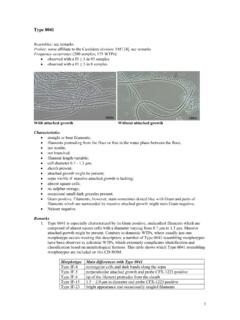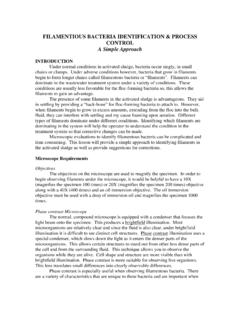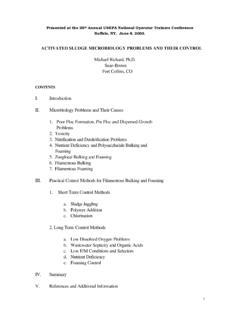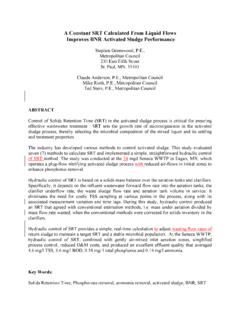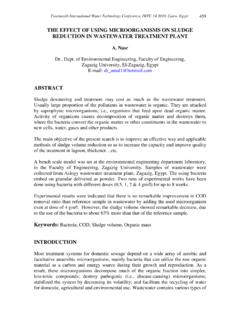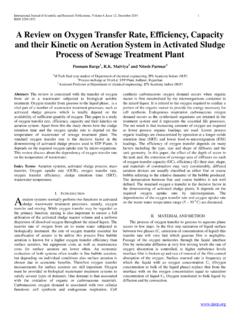Transcription of Thiothrix -021N - Activated Sludge,Process Control ...
1 1 Thiothrix -021N Resembles: Thiothrix -6 (more robust filaments) Probes: class specific: Gam42a [10]; group-specific: G123T [7] and frequently also TNI [16] Frequency occurrence (200 samples; 175 WTPs): observed with a FI 1 in 21 samples observed with a FI 3 in 12 samples Characteristics robust, bent or occasionally even remarkably coiled filaments; filaments present in the liquid between the flocs; rarely tapering of the filaments; rarely rosettes of filaments; filament length variable, but usually >> 200 m; filaments not branched; not motile; cell diameter m, usually ca.
2 M; sheath absent, but the filaments are sometimes surrounded by a layer of slime; attached growth usually absent; septa clearly visible; cell shape highly variable: discoid, almost square and rod shaped and occasionally remarkably swollen cells inside a filament; commonly some dark (necroid) cells in the filaments; sulphur granules might be present in situ. The response to the sulphur deposit test may vary from completely negative to large bright granules in most filaments. However, it happens frequently that (large) granules are formed in just 10 20 % of the filaments, whereas morphologically identical filaments do not contain any sulphur granules; usually Gram negative; nearly always Neisser negative.
3 Remarks The name Type 021n has been used since 1975 to designate unknown filamentous species which more or less comply with the description above [3]. Nowadays it is known that the designation Type 021n stands for a group of filamentous bacteria, all Thiothrix strains ( T. flexilis, T. eikelboomii, 2 T. disciformis), with comparable morphological features, but differing from each other in phylogenetic location and, to some extent, also in their nutritional requirements [1, 4, 7, 8]. Probe G123T is a broad spectrum probe, which hybridises with all Thiothrix strains in Activated sludge [7].
4 It is possible to apply other probes (TNI, G2M or 21N, for example) for a further differentiation of the Thiothrix -021N group [1, 7, 15], but for plant Control this does not make much sense as the growth requirements of the various Type 021n resembling Thiothrix strains do not diverge very much from each other. It has been ascertained during the Macobs and Dynafilm projects that in about 80 % of the sludges, with a large Thiothrix -021N population, the filaments hybridised with G123T as well as with the TNI probe.
5 Physiology Members of the Thiothrix -021N group are fast growing, aerobic species. They have in common that they not only use short chain fatty acids, sugars and several other low molecular compounds for their growth but also derive energy from the oxidation of reduced sulphur compounds such as H2S. However, most Thiothrix -021N strains do not require reduced sulphur compounds for their growth. References for further reading about the physiology of Thiothrix : 1, 5, 11, 12, 13, 14, 17 and 18. Occurrence in Activated sludge Large populations of Thiothrix -021N were present in WTPs treating wastewater from a large variety of industries, fish, pulp & paper, dairy and potato industries.
6 Therefore, it is not possible to correlate this filamentous bacterium with a specific wastewater. It is a very common filamentous species in domestic and industrial plants and growth of Thiothrix -021N is strongly stimulated by an unbalanced influent composition ( lack of N, P, etc.) and low oxygen concentrations in the aeration tank. Control strategies The common possibilities aimed at solving a bulking problem are listed below (1-7). The options 3, 4 and 5 have been successfully applied to Control Thiothrix -021N in many WTPs.
7 However, these strategies failed in plants receiving wastewater rich in reduced sulphur compounds (e. g. paper and pulp industry). If this is the case, an aerated , highly loaded first stage (option 3) is required to remove the sulphur compounds before the wastewater enters the aeration tank. Other low molecular compounds, also stimulating growth of Thiothrix -021N , will be largely removed simultaneously. It is always recommended to test a selected method on pilot scale first, before it is applied full scale.
8 References for further reading about process Control : 2, 6, 9 and 15. 1. Good "House-keeping" 2. Remove deficiencies: O2 > 2 mg/l and BOD:N:P =100:5:1. 3. Two step configuration (aerobic/aerobic or anaerobic/aerobic), in order to remove most of the easily degradable influent fraction before this enters the aeration tank. 4. Aerobic selector. 5. Anoxic zone if sufficient nitrite/nitrate is available for removal of the dissolved fraction from the influent through denitrification. 6. Anaerobic zone if a combination with a Bio-P process is an option.
9 7. Controlling symptoms, viz. applying physical or chemical methods aimed at destroying the filaments or at improving the settling velocity of the flocs by increasing their weight. References 1. Aruga, S., Y. Kamagata, T. Kohno, S. Hanada, K. Nakamura and T. Kanagawa (2002) Characterization of filamentous Eikelboom type 021n bacteria and description of Thiothrix disciformis sp. nov. and Thiothrix flexilis sp. nov. Int. J. of Syst. and Evol. Microbiol. 52, 1309-1316. 2. Eikelboom, D. H. (2000) process Control of Activated sludge plants by microscopic investigation.
10 IWA Publishing, London, UK. 3. Eikelboom, D. H. (1975) Filamentous organisms observed in Activated sludge . Water Research 9, 365-388. 4. Howarth, R., R. F. Unz, E. M. Seviour, L. L. Blackall, R. W. Pickup, J. G. Jones, J. Yaguchi and I. M. Head (1999) Phylogenetic relationships of filamentous sulfur bacteria ( Thiothrix spp. and Eikelboom type 021n 3 bacteria) isolated from wastewater treatment plants and description of Thiothrix eikelboomii sp. nov., Thiothrix unzii sp. nov. , Thiothrix fructosivorans sp.

